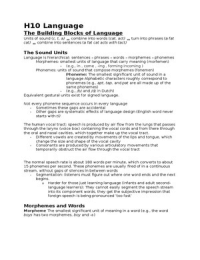H10 Language
The Building Blocks of Language
Units of sound (c, t, a) combine into words (cat, act) turn into phrases (a fat
cat) combine into sentences (a fat cat acts with tact)
The Sound Units
Language is hierarchical: sentences – phrases – words – morphemes – phonemes
Morphemes: smallest units of language that carry meaning (morfemen)
- (e.g., in , come , -ing , forming incoming )
Phonemes: units of sound that compose morphemes (fonemen)
Phoneme: The smallest significant unit of sound in a
language Alphabetic characters roughly correspond to
phonemes (e.g., apt, tap, and pat are all made up of the
same phonemes)
- (e.g., /b/ and /d/ in Dutch)
Equivalent gestural units exist for signed language.
Not every phoneme sequence occurs in every language
- Sometimes these gaps are accidental
- Other gaps are systematic effects of language design (English word never
starts with tl)
The human vocal tract: speech is produced by air flow from the lungs that passes
through the larynx (voice box) containing the vocal cords and from there through
the oral and nasal cavities, which together make up the vocal tract.
- Different vowels are created by movements of the lips and tongue, which
change the size and shape of the vocal cavity
- Consonants are produced by various articulatory movements that
temporarily obstruct the air flow through the vocal tract
The normal speech rate is about 180 words per minute, which converts to about
15 phonemes per second. These phonemes are usually fired of in a continuous
stream, without gaps of silences in between words
- Segmentation: listeners must figure out where one word ends and the next
begins.
o Harder for those just learning language (infants and adult second-
language learners): They cannot easily segment the speech stream
into its component words, they get the subjective impression that
foreign speech is being pronounced ‘too fast’
Morphemes and Words
Morpheme The smallest significant unit of meaning in a word (e.g., the word
boys has two morphemes, boy and –s)
, Content Morphemes and Function Morphemes
Content morpheme A morpheme the carries the main semantic and referential
content of a sentence. In English content morphemes are usually nouns, verbs,
adjectives, or adverbs. (e.g.bake and man)
Function morpheme A morpheme that, while adding such content as time,
mode, individuation, and evidentially, also serves a grammatical purpose (e.g,.
the suffixes –s and –er, or the connecting words and or if)
- Distinction of morpheme type exists in all languages.
- Content and function morphemes are processed in different ways during
normal language activities (rely on partly different brain circuits and are
sited differently in the brain)
o In brain injury a person’s ability to utter or process function
morphemes may be compromised while the content words remain
intact
Phrases and Sentences
Rules of syntax (or grammar) The regular principles governing how words can
be assembled into sentences
- Grammaticality depends not directly on meaning, but on conformance with
some rule-like system
o Some words are easily interpretable, but still seem badly
constructed (that infant seems sleeping)
o Some sequences are nog interpretable, but seem well constructed
even so (colorless green ideas sleep peacefully)
- These latter rules are some people’s prescriptions for how language should
be (rather than how it really is), a matter that usually is based on which
dialect of language has the most prestige or social cachet
- Noam Chomsky (1928 - ) : ’We put our words together in ever new
sentences to mean ever new things, but we have to do so systematically or
our listeners won’t be able to decipher the new combinations
The Basics of Syntactic Organization
Tree diagram A geometric representation of the structure of a sentence. Its
nodes are labelled with phrase –(e.g. noun phrase) and word-class (e.g. adjective)
category names, and the descending branches indicate relationships among
these categories
- Useful way of showing that individual sentences comprise a hierarchy of
structures
Phrase structure description A tree diagram of labelled bracketing that shows
the hierarchical structure of a sentence (how the sentence can be analysed into
phrase units, the tree shows the words of the sentence at the bottom row in the
tree)
- Other languages choose wholly or partly different orderings of words inside
the phrase (the green shirt(English), la chemise verte (French)), and of
phrases within the sentence, but they make their phrase structure choices
just as regularly and systematically as does English
- Study: the function morphemes allowed the listeners to organize the
sequence as a phrase structures, and these sequences were appreciably
easier to remember and repeat (memorizing strings of nonsense words
that they heard spoken)




